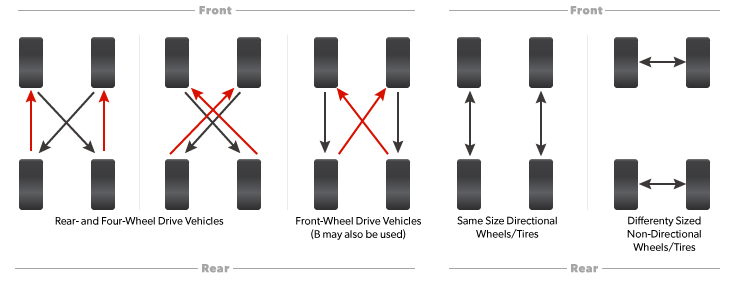You just spent upwards of $400 or more — most likely way more — to outfit your vehicle with dependable tires. That’s a big financial investment, so it makes sense to take good care of them. Follow these tire maintenance tips to get the most miles out of your tires.
Key tire maintenance points for longevity
Proper air inflation is critical for the safety of the tire and handling of the vehicle. Over-inflating tires can causes stress on the sidewall of the tire and may cause a blow-out during an impact collision or striking a pothole. Over-inflating can also cause a crowning of the center tire tread, creating uneven wear in the center of the tire tread.
On the other hand, under-inflating tires also weakens the sidewall of the tire and won’t support the vehicle properly. On an under-inflated tire you’d expect to see excessive wear on both other edges of the tire. An under-inflated tire could have a blow-out when hitting a pothole or the vehicle may hydroplane in wet conditions. Each vehicle manufacturer has a placard installed in every vehicle they make, indicating the proper air inflation for tires in winter and in summer. Our experts rely on these guidelines from the manufacturer for proper tire inflation.
Notice your low tire pressure light come on in cooler temperatures? That’s not a surprise. When temperatures begin to drop in the fall, the air becomes denser and it lowers the tire pressure inside the tire. According to Consumer Reports, you can expect a drop in pressure about 1 PSI for every ten degrees Fahrenheit drop in air temperature. We recommend checking air pressure regularly, even if the warning light on the dash isn’t on.
It’s a good habit to perform a visual inspection of tire condition. Make this part of your monthly tire maintenance that you can do at home. Bulges or cuts (especially after hitting a pothole or curb) can indicate internal structural problems with the tire. Left not repaired, you risk a serious handling issue with the vehicle.
Tire balance and rotation for smooth riding
Besides proper inflation and regular visual inspections, rotating tires on a regular basis helps maintain even tire tread wear and prolong the life of your tires. Oftentimes, the tire manufacturer requires regular rotation in order to not void the tire warranty. Failing to rotate creates uneven wear and causes poor handling of the vehicle. We recommend rotating tires between every 6,000 and 10,000 miles. We find it’s easier to keep track of when rotations are scheduled with regular oil changes.
Tires are are always balanced after being mounted to the wheel. Why is balancing done? Because no wheel or tire is perfectly round. Also, weight distribution in either isn’t perfect. By adding slight weight (in ounces), and spin balancing it’s possible to create a smooth and vibration-free rotation. Tires that are unbalanced will have a vibration possibly combined with noise, and may become uneven in the tread wear. Unbalanced tires also negatively affect the suspension of your vehicle, not to mention ride comfort. It’s a good idea to have the balance of your tires checked at least every 18-24 months, or more often in areas with poor road conditions and potholes, or if you frequently drive on dirt roads.

Tire Rotation Patterns
Depending on the type of tire your vehicle has, directional, asymmetrical or open shoulder, tire rotations should be performed regularly by your technician. Conventional rotation patterns are shown in the illustration above.
Performance tire and wheel trends have created the need for additional tire rotation patterns:
- The “Front-to-Rear” pattern may be used for vehicles equipped with the same size directional wheels and/or directional tires.
- A “Side-to-Side” pattern may be used for vehicles equipped with different sized non-directional tires and wheels on the front axle compared to the rear axle.
What to do if you notice uneven tire wear on your tires? Make an appointment with us right away for a suspension and tire inspection. Uneven tire wear can be a result of worn suspension components, not just tire balance or inflation. If your car feels like it is pulling or if you have to turn the steering wheel to drive straight, your wheels may be out of alignment, or the suspension needs attention. If its time for new tires, check our tire rebate page for special offers.

